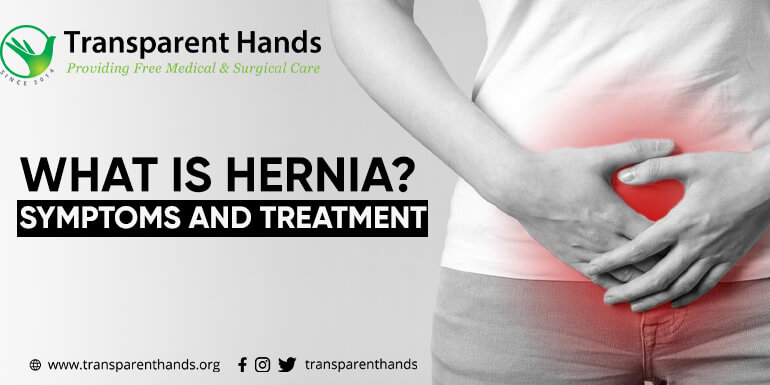What are the Causes & First Signs of Hernia

What is Hernia?
A hernia occurs when one of the internal organs pushes through a weak spot in the tissues or muscles. Typically, most hernias occur inside the abdominal cavity, in the area between the chest and hips. The causes of hernia are numerous but early symptoms and signs of hernia include a swelling beneath the skin of the abdomen or groin.
Hernias are classified into different types, some of which are as follows:
1- Inguinal Hernia: The inguinal hernia is the most commonly reported type of hernia. During an inguinal hernia, a part of fatty tissues or intestine protrudes into the groin; men are more affected by it than women.
2- Femoral Hernia: In this type of hernia, fatty tissues/bowels protrude through a patient’s groin at the top of the inner thigh. In a femoral hernia, the hernia pushes through a weak spot in the abdominal wall into an area known as the femoral canal.
3- Umbilical Hernia: Fatty tissues or a part of the intestine pushes through the abdomen near the belly button.
4- Hiatus Hernia: In a hiatus hernia, a portion of the stomach pushes into the chest cavity via an opening in the diaphragm.
Apart from these, there exist other types of hernia as well. These include incisional hernia, epigastric hernia, diaphragmatic hernia, and Spigelian hernia. In terms of percentages, 75-80% of the hernias are inguinal or femoral, 2% of these are ventral, 3-10% are umbilical, and 1-3% other types.
What Does a Hernia Feel Like?
Hernia patients often describe their condition as mild pain, pressure at the site of the hernia, or discomfort. The situation aggravates considerably when strain is put on the abdomen. Here, we refer to strain as any pressure exerted during heavy lifting, running, or passing bowels. It is important to note that some patients may have bulges but don’t report any discomfort.
What are the First Signs of Hernia?
The early symptoms and signs of hernia include a swelling beneath the skin of the abdomen or groin. The protrusion can be tender and may disappear completely when the patient lies down. However, the intensity of these signs and symptoms of hernia can vary from patient to patient. For example, most patients feel heaviness in the abdomen, often coupled with constipation or bloody stools. Furthermore, some patients may also feel discomfort in the groin region when bending or lifting stuff, coupled with an aching sensation at the bulge. Some other signs of hernia associated with hernia include heartburn, shooting pain, vomiting, and constipation. Some patients also report pain and swelling around the testicular region.
What Causes Hernia?
The causes of hernia are numerous. Hernias are often caused by weakened muscles that are normally present since birth. Hernias are also associated with aging and repeated strains. The reasons for these strains can be various. Some of these reasons include physical exertion, pregnancy, putting pressure while passing bowel, or frequent coughing. In the case of adults, straining the abdominal area, putting on excessive weight, or birth can lead to an umbilical hernia. Weakening of the diaphragm with the passing years or putting pressure on it is one of the leading causes of Hiatal hernia.
How Serious Is A Hernia?
Not all hernias are serious. Inguinal hernias, in particular, are not dangerous. However, they do not improve on their own. Hence, they can lead to life-threatening complications. Physicians are likely to prescribe surgical treatment for fixing an inguinal hernia, which is the most common type of hernia. Surgeries are recommended when the hernia is super painful or enlarging with time. Inguinal hernia repair is one of the more commonly performed surgical treatments.
Hernia Treatment
Watchful waiting is something that doctors usually prescribe if hernias are small and not bothersome. Sometimes, an individual suffering from a hernia might have to wear a supportive truss. However, this is something that must be done only on the advice of a doctor. Surgical treatment is the best way to relieve any discomfort in case of enlarging hernias that become painful with every passing day.
There are two types of surgical treatments for a hernia. These are open hernia repair and minimally invasive hernia repair. In open hernia repair, an incision is made in the groin, and the protruding tissues are sent back into the abdomen. Weakened areas are sewed back and may be reinforced using a synthetic mesh. Stitches are then used to close the opening.
In the case of minimally invasive hernia repair, several incisions are made in the patient’s abdomen. The surgery is performed using laparoscopic instruments. Doctors often inflate the abdomen with gas to ensure that the internal organs are easily visible.
Cost of Hernia Treatment
For hernia patients who hail from underprivileged backgrounds, affording a hernia surgery can be extremely challenging. That’s where organizations like Transparent Hands save the day by funding the hernia treatment of such patients.
Free Hernia Treatment & Transparent Hands
Transparent Hands is one of the biggest charity platforms in Pakistan’s healthcare sector. The charity organization in Pakistan strives hard to make a difference in patients’ lives. The organization helps deserving patients by conducting free medical camps and funding medical and surgical treatments. Transparent Hands also provides free hernia surgeries to underprivileged patients. One hundred percent transparency is a hallmark feature of this organization. Donate today.
(The information in this article should not be taken as a substitute for professional medical advice.)










Leave Your Comments